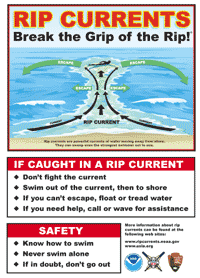When You Find Yourself In Rough Waters What Happens When Exhilarating Turns Into Terrifying? In the last issue, I stated that “living in the current” produces feelings of both calm and excitement which indicate that you’re on the right track. One reader and small business owner wrote to say that while he’s on the right track now, he had just come out of a rough second quarter. He and his partner had experienced “business events we had no control over and felt a bit swept down the river, looking for a rope”. Living in the current doesn’t mean it’s always smooth sailing. (Pardon the mix of river and ocean metaphors.) What happens when you find yourself in rough waters? Never Swim Against The Current
What’s interesting is that while a rip current will carry you away from the shore, it will not pull you under water, as you might imagine it would. Rip current victims drown because they become exhausted fighting the current in a panicked attempt to swim directly back to the shore. Since it is not humanly possible to swim against a riptide, the smart thing to do is to:
The NOAA also provides these additional tips:
How do these riptide lessons translate to our everyday lives on land? I can see a correlation with every single tip above. Swimming across the rough waters of any situation means being willing to take a different approach. Going with the current or waiting for a rough current to subside requires giving the situation some extra time and space for progress to happen naturally, instead of trying to force an instant resolution. Remember To Swim Across Think of a time when you encountered rough waters. Did you fight the current and struggle, insisting on heading to shore directly, or did you try a different approach and swim across? This Week: As you encounter rough patches and scary waters, try moving with the current, even though it may take you further away from shore temporarily. You will then have the perspective and ability to swim back with more ease. Here's to you, Notes: |
||
|
||

 The
signs at the beach warn about rip currents (also known as riptides
or undertows). They account for 80% of rescues performed by surf
beach lifeguards. There is a concerted effort by the National
Oceanic and Atmospheric Administration (NOAA) and the United States
Lifesaving Association (USLA) to educate people on how to survive
a rip current.¹
The
signs at the beach warn about rip currents (also known as riptides
or undertows). They account for 80% of rescues performed by surf
beach lifeguards. There is a concerted effort by the National
Oceanic and Atmospheric Administration (NOAA) and the United States
Lifesaving Association (USLA) to educate people on how to survive
a rip current.¹